- Our Research
- Research Areas
- Addictions
- Aging & Geriatrics
- Behavior Change
- Biostatistics
- Cancer
- Cardiovascular Health
- Child & Adolescent Health
- Chronic Illness Management
- Health Informatics
- Health Services & Economics
- Healthy Communities
- Medication Use & Patient Safety
- Mental Health
- Obesity
- Preventive Medicine
- Social Determinants of Health
- Vaccines & Infectious Diseases | COVID-19
- Our Scientists
- Collaborate with Us
- Our Publications
- Research Funding Sources
- Research Areas
- News and Events
- Get Involved
- About Us
- Live Healthy
Conducting Your Codesign
The ENSPIRE Playbook
Setting the Stage | Mapping and Organizing Your Codesign | Conducting Your Codesign | Producing and Sharing Your Codesign Projects | Evaluating Your Codesign | Recommendations Based on Lessons Learned | About the ENSPIRE Study
 Develop your codesign curriculum
Develop your codesign curriculum
![]()
Curriculum content and techniques
- How much background material regarding the topic of focus do you want to share with codesigners?
- What expertise do codesigners bring to the process that they will want to share with their peers?
- Will you use homework/assignments outside of sessions as a tool for participation and engagement? If so, what do you need to share during sessions to convey these assignments?
- What kinds of activities or exercises would be effective for working through ideas or questions during sessions? What activities feel right for your topic and community?
Rapport/building comfort
- Do your codesigners already know each other? If not, how much time do you want to spend each week on developing rapport with one another?
Mode and equipment
- How will you share materials during codesign sessions: paper, poster, whiteboard, slides, video, presentation/lecture?
- If meeting in person, what kinds of tangible materials will you use? White board, sticky notes, notepads?
Pacing
- How many hours/days/weeks/months are you using for codesign? What is your codesigner availability like?
- How does the meeting time of day impact how long codesigners would want to spend in a meeting?
- How much flexibility will you build into your curriculum — how fluid will it be?
Writers/developers/presenters
- How much input will people in different roles have in developing the curriculum? Project staff? Facilitators? Community partners? Codesigners?
- Will you invite “experts” to join sessions to share content?
![]()
ENSPIRE developed a 10-week curriculum that codesign teams could modify as needed
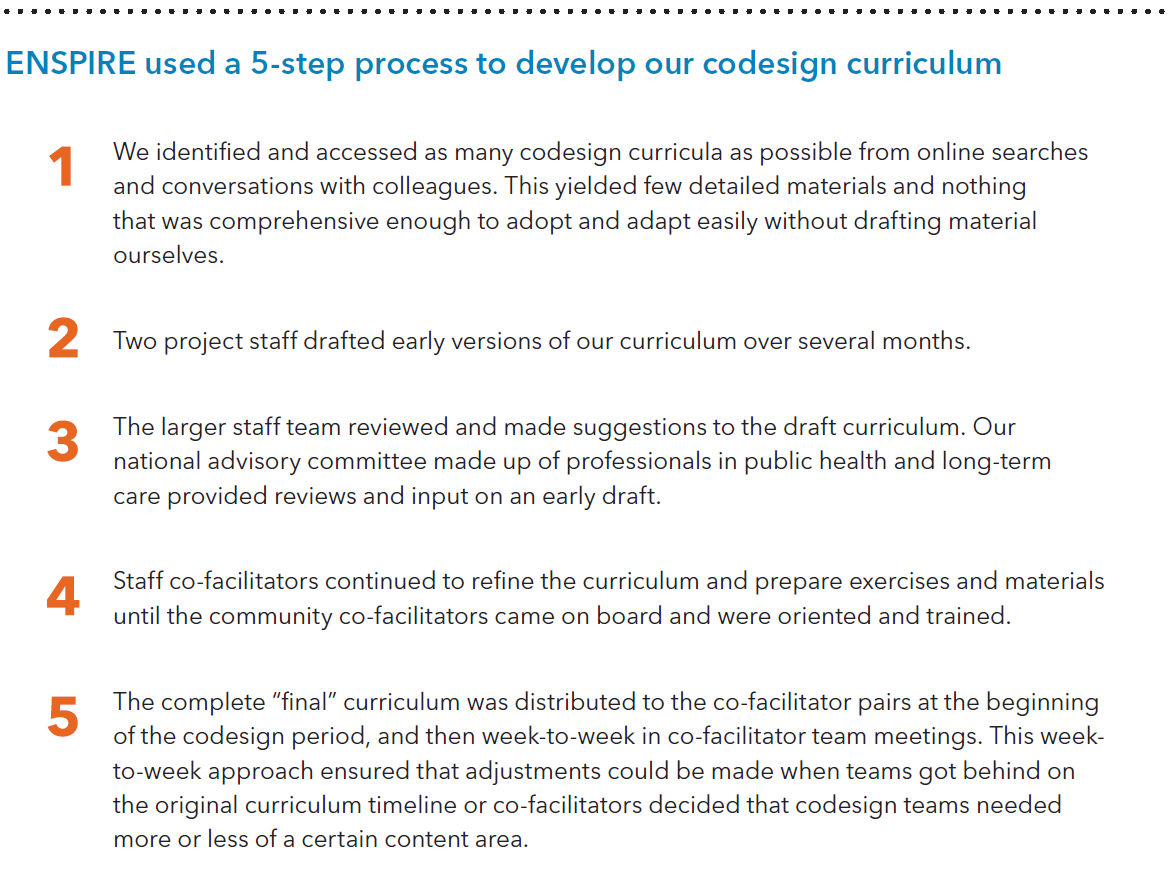
ENSPIRE’s curriculum at a glance
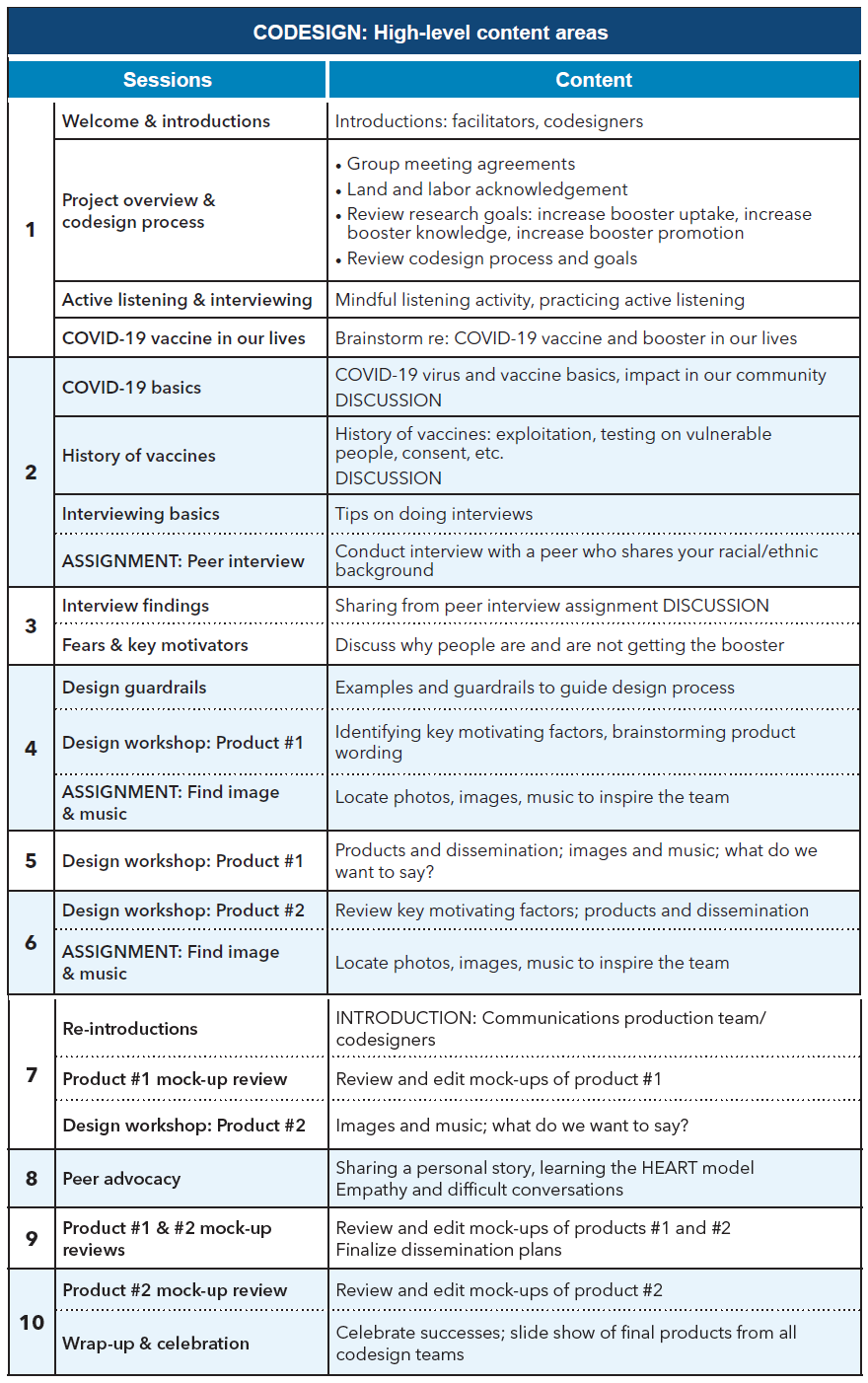
For each codesign session, we prepared a slide deck, icebreaker topics, handouts, and other visuals, such as video clips. This was a critical step that took time for staff to draft and for co-facilitators to review and adapt.
Co-facilitator pairs were empowered to adapt the slide decks and curriculum as necessary to fit their individual teams. These adaptations proved minimal but significant for co-facilitators to feel confident about using the curriculum with their teams.
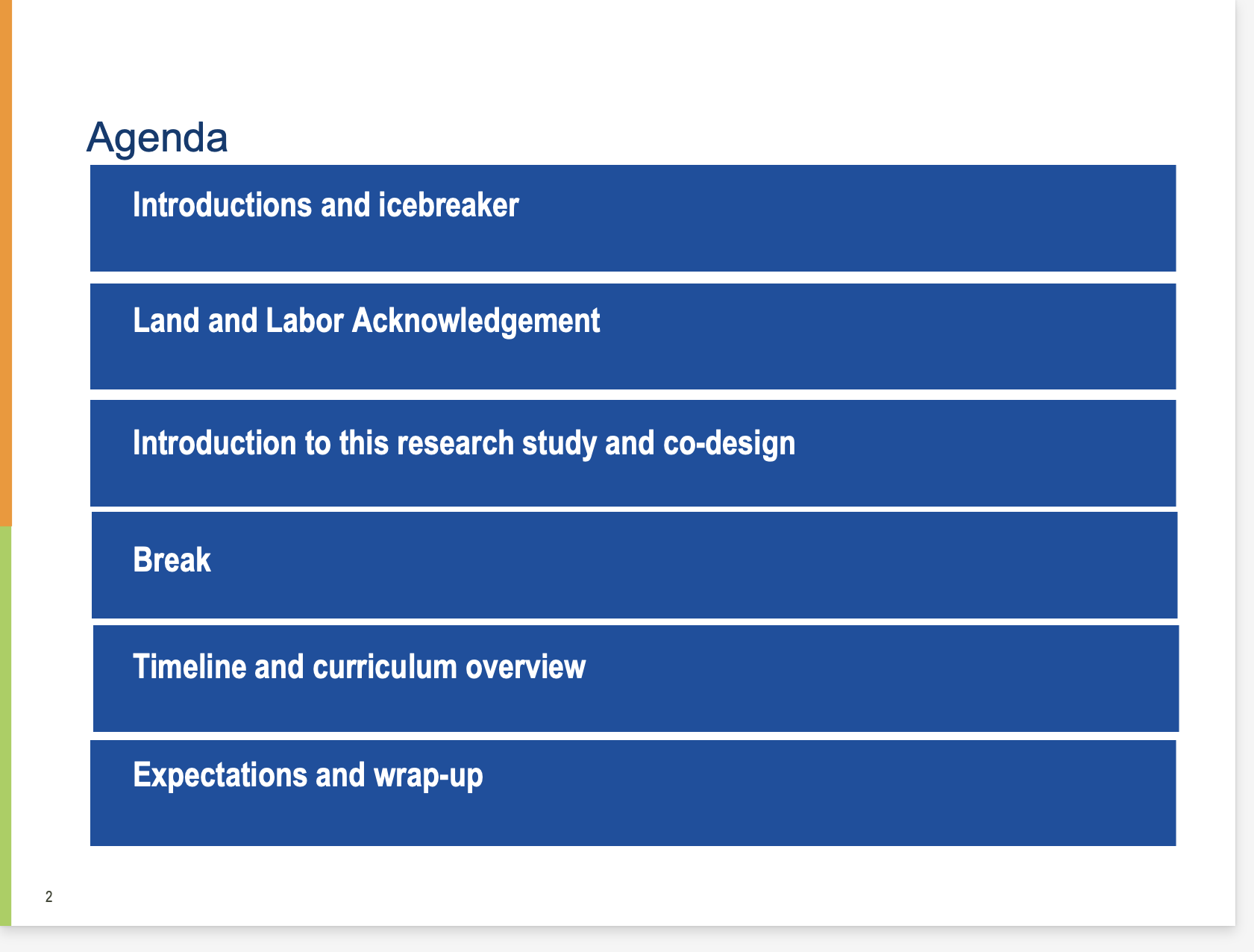
 Train, engage, and support facilitators
Train, engage, and support facilitators
![]()
Orientation and training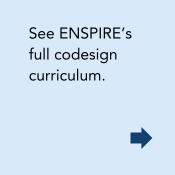
- Will your facilitators benefit from both an orientation (an overview of codesign) and a training (an in-depth review of the step-by-step process and the curriculum)?
- How much training do your facilitators need?
- Are they familiar with the content area or problem you are addressing?
- Do they have good group facilitation skills already?
- Are you building the curriculum together or training them in something you have developed — or somewhere in between those two?
Engagement, meetings, support
- How often will your facilitators meet to debrief after codesign sessions and prepare for upcoming sessions?
- How will you share impressions, learnings, and inspiration between facilitators?
- How will you compensate your facilitators? How much is reasonable, and what will be a feasible mechanism for paying them?
![]()
ENSPIRE provided orientation, training, payments, and regular team meetings for facilitators
Orientation and training
Our orientation and training goals were to provide community co-facilitators with a foundation to function as equals with their staff co-facilitator counterparts. We intentionally designed the trainings as an abridged version of the curriculum the co-facilitators would be delivering during the codesign period.
Over 3 meetings, we covered the following content areas:
- Orientation
- ENSPIRE study overview, including study goals, intervention, and research methods
- Timeline
- Curriculum overview
- Expectations for co-facilitators (meeting times, meeting etiquette, absences)
- Necessary Zoom skills
- Training #1
- Participating long-term care communities
- COVID-19 in long-term care communities (conversation)
- COVID-19 vaccine and booster in our lives (conversation)
- Reviewing a COVID-19 video
- Group facilitation
- Training #2
- Mindful listening
- Communicating about vaccines (conversation)
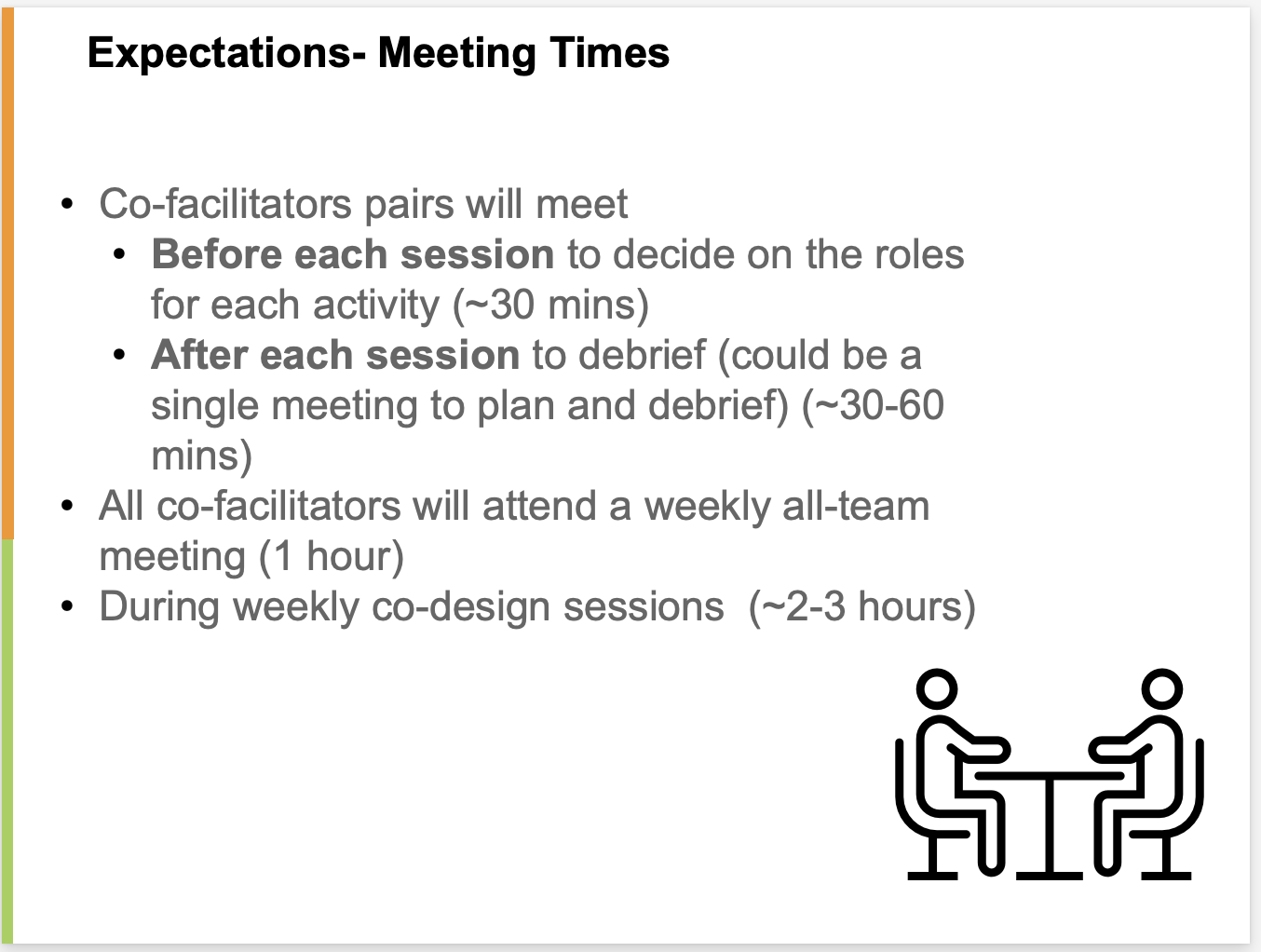
- Roles and services from our communications production team
- Curriculum handbook
- Logistics Q&A
Although the orientation and training sessions were designed primarily for our community co-facilitators, our staff co-facilitators attended as well. The orientation and trainings were all scheduled the week before the codesign meetings started to ensure this was fresh in co-facilitators’ minds.
Engagement, meetings, support
- Facilitator meetings
- All-facilitator meetings: All our facilitators met weekly to debrief the previous session and become oriented on the next week’s session. The upcoming week’s curriculum and slides were reviewed as a group.
- Co-facilitator meetings: Co-facilitator pairs also met immediately following each week’s codesign session to debrief with each other, assign duties, and problem-solve any issues anticipated for the next week’s session.
- Compensation
- Our community co-facilitators were paid $60/hour for all time contributed to the project, including orientations and trainings, meeting planning, and codesign sessions. Because we were working within a large research organization, we had to work with bureaucratic challenges of contracting the facilitators and processing their payment, which required time and patience.
 Gear up for codesign sessions: online versus in person
Gear up for codesign sessions: online versus in person
![]()
- Considering your codesigners, how would in-person versus online meetings be beneficial?
- What would be the challenges of meeting in person versus online?
- Will your budget cover the costs of in-person meetings? What about the costs of supporting online meetings?
- If you hold meetings online, are some codesigners more likely to take part (for example, codesigners with disabilities)?
- What kind of technology will your codesigners need if you hold meetings online? Can your organization assist with this?
- Are there codesigners who would have challenges with the technology involved in online meetings?
- What kinds of ongoing tech support will you need to provide to codesigners and facilitators if codesign takes place online?
![]()
Online codesign was better for ENSPIRE but required equipment, training, ongoing technical support
We had originally considered the possibility of holding in-person codesign meetings. We quickly realized that would not be feasible. We identified the following challenges to using in-person meetings for our project:
- Our codesigners were distributed over a large geographic area in each state. Bringing them together in person would have required a lot of travel time, and the travel burden may have prevented some codesigners from taking part.
- Expenses for meeting in person — such as travel costs, lodging, time from work, and childcare — would have quickly increased for the project and for individual codesigners.
- We were working with a low-wage workforce under immense strain due to staffing shortages. It would not have been feasible to ask people to take time off work to attend codesign meetings. Instead, they attended online after work, and some even attended while at work because they could get short-term coverage to take part.
The decision to meet online presented a unique set of planning considerations. We allocated resources for the following:
- Providing loaner iPads with data service to codesigners without adequate devices or internet service for meeting online
- Allocating staff to provide ongoing technical support for codesigners
- Training codesigners to use Zoom
- Training staff to use Zoom fluidly, including instruction on more complex meeting tools to make the meetings engaging and seamless
- Ensuring all materials were developed for an online environment
 Engage, support, and build trust with codesigners
Engage, support, and build trust with codesigners
![]()
Orientation
- Would it be helpful to have a one-on-one orientation meeting with each of your codesigners before the start of the codesign sessions?
Communication
- Considering your codesigners, what are the best ways to communicate with them before and after codesign sessions if necessary? When will you ask them about their preferences for communication?
- What frequency of meeting reminders, if any, would your codesigners appreciate?
Meeting norms and icebreakers
- Will you suggest meeting norms with your codesign team(s), or ask them to suggest norms, or something else? How familiar will they be with this concept of “norms”?
- How often do you want to do icebreakers at the beginning of sessions, and how much time can you allocate for that?
Compensation
- How will you compensate codesigners — how much, through what mechanisms, and how will you describe the compensation?
Feeding your codesigners
- If you are meeting in person, will you provide food at codesign meetings? What logistical issues related to providing food will you consider and resolve in advance? If you are unable to share a snack or meal in person, how will you create a similar sense of community?
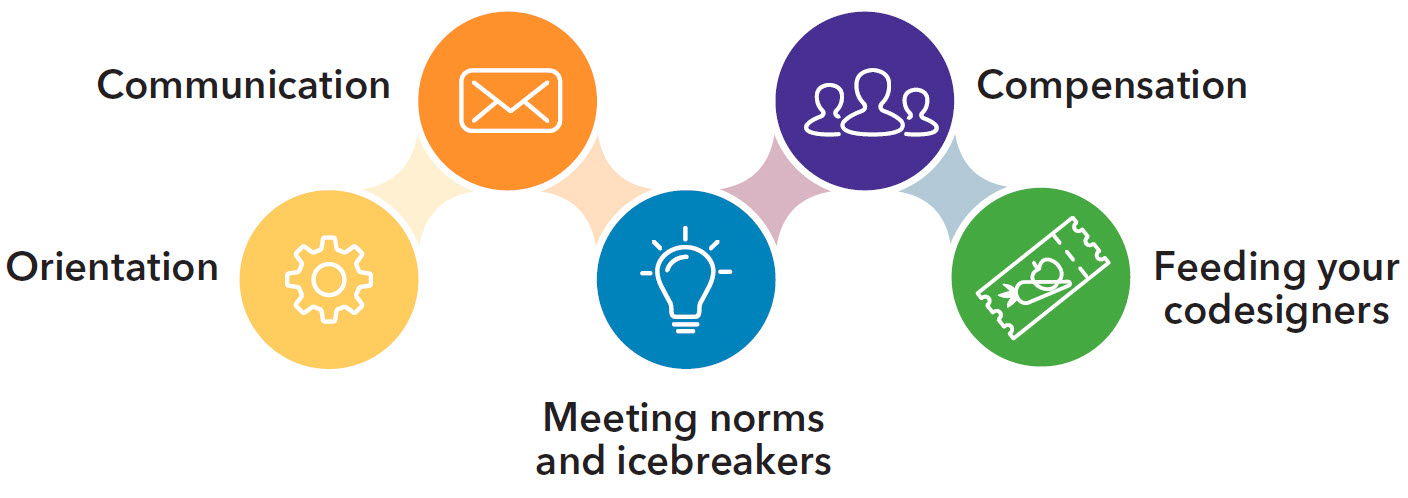
![]()
ENSPIRE used phone calls, text reminders, meeting norms, icebreakers, payments, and meal coupons
Orientation phone calls
Before the first codesign session, every codesigner received a phone call from their staff co-facilitator who reviewed the purpose of codesign, discussed the virtual meetings and the need for online access, and answered codesigner questions. This was the first time we offered to provide technical support and identified any codesigners who would need equipment (an iPad) provided by our project to participate.
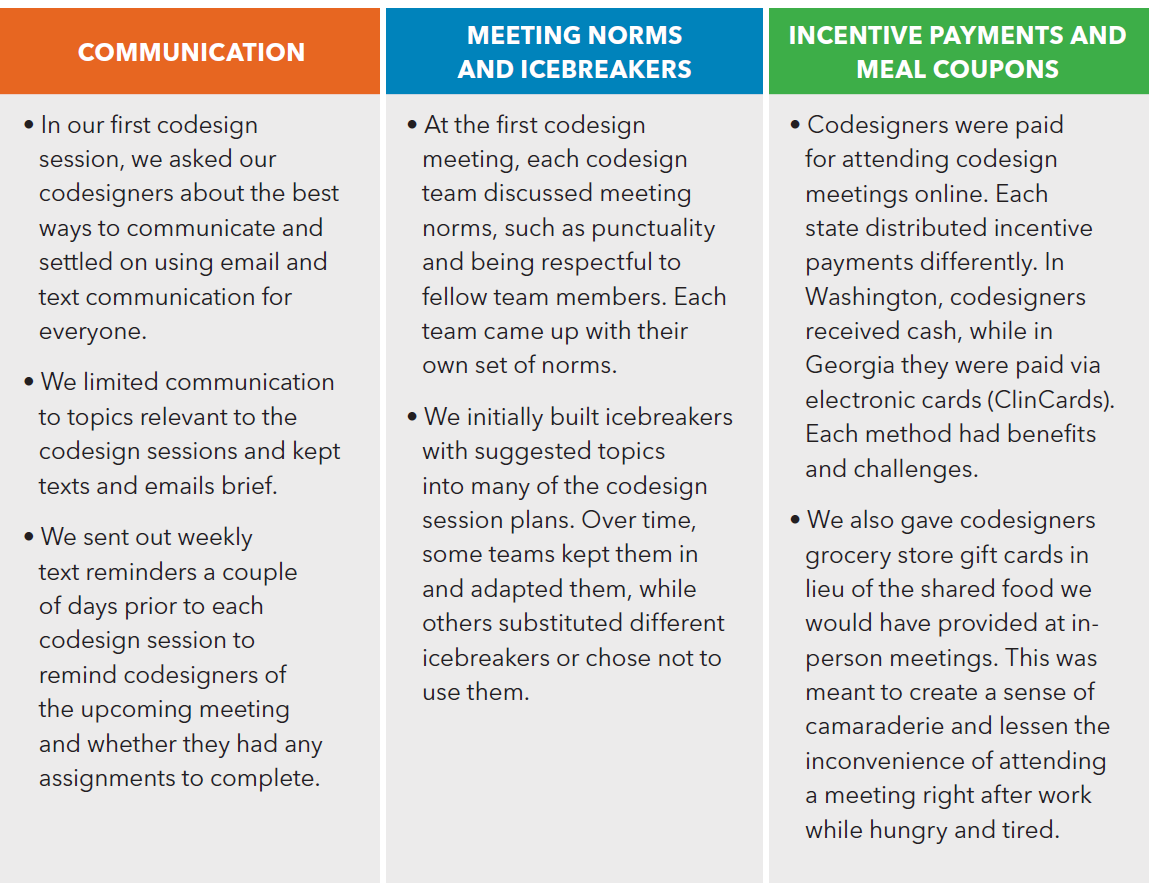
 Hold regular codesign sessions
Hold regular codesign sessions
![]()
- How many days/weeks/months do you want to spend on codesign?
- How often will your codesign team(s) meet?
- How long will sessions be?
- What time of day and day of week make the most sense for your codesigners?
![]()
ENSPIRE had codesign sessions weekly, over 10 weeks

Kaiser Permanente Washington Health Research Institute for:
Kaiser Permanente Washington Health Research Institute
Phone: 206-287-2900Fax: 206-287-2871
Contact us
Sign up for our newsletter
Policy on Conflict of Interest
Nondiscrimination Notice and Language Access Services
Land Acknowledgment
Our Seattle offices sit on the occupied land of the Duwamish and by the shared waters of the Coast Salish people, who have been here thousands of years and remain. Learn about practicing land acknowledgment.


